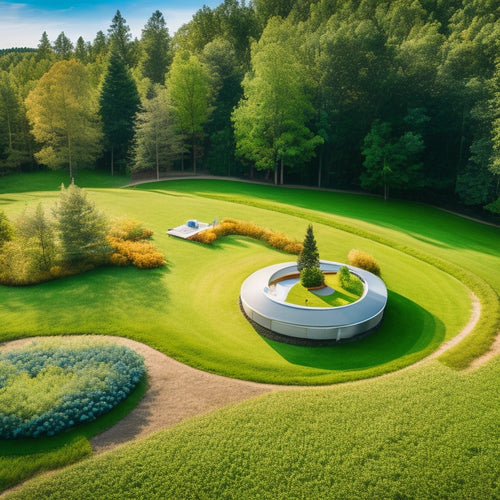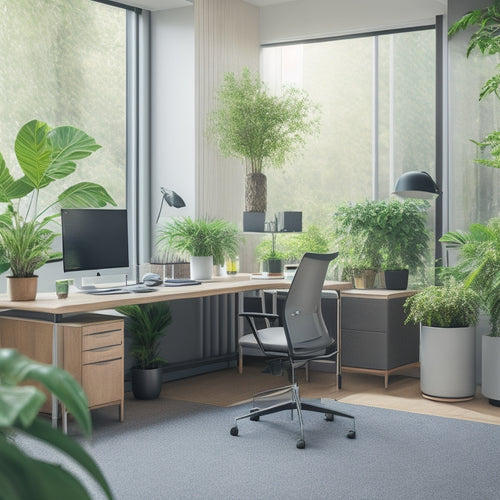
Space-Maximizing Vertical Gardens for Compact Urban Balconies
Share
You're looking to change your compact urban balcony into a lush oasis, and with vertical gardening, you can do just that. Start by maximizing space with trellises that support climbing plants, and incorporate wall-mounted planters that create additional growing surfaces. Consider DIY vertical garden frames made from waterproof materials or space-saving hydroponic systems for efficient nutrient management. By selecting the right plants and designing a tiered planter system, you can create a beautiful and functional space that suits your style. As you investigate these innovative solutions, you'll uncover more ways to optimize your compact balcony's potential.
Key Takeaways
- Use trellises, wall planters, and vertical hydroponic systems to maximize vertical space in compact urban balconies.
- Compact wall-mounted planters with self-watering systems and hanging basket gardens are ideal for small spaces.
- Tiered planter systems and lightweight materials can be customized to fit various styles and space constraints.
- Implement drip irrigation and renewable energy solutions for sustainable and efficient watering.
- Regularly monitor plant health, prune regularly, and rotate crops to maintain soil health and prevent overcrowding.
Maximizing Space With Trellises
Since urban balconies often have limited floor space, maximizing vertical space becomes essential for creating a thriving garden. You can achieve this by incorporating trellises, which come in various types, such as obelisks, arbors, and screens. These structures support climbing plants, adding a vertical aesthetic to your garden.
When choosing plants, consider those that thrive in sunlight exposure, and implement irrigation solutions to guarantee they receive adequate water. By embracing sustainable practices, such as using Renewable Energy Sources for powering your irrigation systems, you can minimize your garden's carbon footprint.
Seasonal planting allows you to switch up your garden's look throughout the year, attracting urban wildlife and adding visual interest. By optimizing space efficiency with trellises, you'll create a lush oasis that's both functional and decorative.
Compact Wall-Mounted Planters
You can further optimize your urban balcony's vertical space with compact wall-mounted planters, which are specifically designed to hold a variety of plants without taking up precious floor space.
These planters often feature self-watering systems, ensuring your plants receive the right amount of moisture without constant attention.
By incorporating renewable energy solutions like solar panels or biodiesel fuel systems, you can power your irrigation systems sustainably.
By using compact wall-mounted planters, you can enjoy the many benefits of a vertical garden, including increased greenery, improved air quality, and enhanced aesthetic appeal.
Plus, they're perfect for small balconies, allowing you to make the most of your outdoor space.
With the right planter, you can cultivate a thriving garden that brings freedom and flexibility to your urban oasis.
Hanging Basket Vertical Gardens
When designing a hanging basket vertical garden, you'll want to take into account the size of your baskets, as larger ones can hold more plants and require less frequent watering.
Incorporating solar-powered charging solutions into your urban balcony can also promote energy independence and reduce carbon emissions.
You'll also need to choose plants that thrive in a hanging environment, such as trailing species or those that can tolerate some shade.
Basket Size Matters
Your hanging basket's dimensions greatly impact its ability to thrive as a vertical garden on your urban balcony. A deeper basket allows for better root growth, while a wider one provides more space for vertical layering and plant accessibility.
When selecting a basket, consider investing in eco-friendly materials that promote sustainability, such as biodegradable options that reduce environmental footprint. Look for lightweight materials that promote moisture retention and incorporate drainage solutions to prevent waterlogged soil.
Consider color coordination to enhance the aesthetic appeal of your garden. As you plan, remember to account for seasonal changes and adjust your maintenance tips accordingly.
Plant Selection Tips
Selecting the right plants is vital to creating a thriving vertical garden in your hanging basket. You'll want to choose plants that are suitable for indoor-outdoor conditions and can thrive in a compact space. Consider the following:
-
Drought tolerant plants and vertical succulents that can survive with minimal watering, perfect for busy urban dwellers.
-
Edible herbs like basil, mint, and rosemary that can add fresh flavor to your cooking and fragrance plants like lavender that can create a calming atmosphere.
-
Native species and seasonal flowers that attract local pollinators and add color to your balcony, while companion planting can help deter pests and improve growth.
When designing your vertical garden, consider incorporating energy storage systems solar energy utilization to power your irrigation system, making it more sustainable and energy-efficient.
Regular maintenance, including cleaning and inspecting connections, is vital for optimizing performance and guaranteeing longevity.
Remember to select pest resistant varieties to minimize maintenance and guarantee your vertical garden remains healthy and thriving.
Tiered Planter Systems Design
Tiered planter systems, a space-saving marvel, offer a versatile design solution for urban balconies. You can customize them to fit your style and space constraints. When designing your tiered planter system, consider the aesthetics and materials that fit your vision.
| Tiered Planter Aesthetics | Tiered Planter Materials | Benefits |
|---|---|---|
| Modern, sleek | Stainless steel, aluminum | Durable, low maintenance |
| Rustic, natural | Wooden planters, bamboo | Adds warmth, cozy ambiance |
| Playful, fanciful | Colorful ceramics, terra cotta | Adds personality, visual interest |
DIY Vertical Garden Frames
You'll need to choose a suitable frame material that can support the weight of your plants and withstand outdoor conditions, such as waterproof PVC, aluminum, or recycled plastic.
Next, consider the plant holder design, which can be pockets, planters, or a trellis system, depending on the type of plants you want to grow.
Frame Material Options
By the time you're ready to build your DIY vertical garden frame, you've likely given some thought to the type of plants you want to feature and the space available on your urban balcony.
Now, it's time to reflect on the frame material options that will best support your plants and complement your balcony's aesthetic.
You can choose from:
-
Aluminum frames that are lightweight, weather-resistant, and easy to customize to fit your balcony's dimensions
-
Wooden trellises that offer a natural, eco-friendly alternative with a range of aesthetic choices
-
Recycled materials that provide a sustainable option for environmentally conscious urban gardeners, often with durable finishes and modular systems for easy assembly
Plant Holder Designs
With your frame material selected, it's time to focus on the plant holder designs that will bring your DIY vertical garden to life.
You'll want to choose a design that complements your frame and meets your plants' needs. Consider self-watering planters that reduce maintenance and guarantee your plants receive the right amount of moisture.
Modular planter systems are also a great option, allowing you to easily add or remove planters as needed. This flexibility is ideal for urban balconies where space is limited.
Look for designs with built-in irrigation systems and aeration pockets to promote healthy root growth.
Space-Saving Configurations
These urban balcony spaces can be optimized for maximum greenery with space-saving configurations that make the most of your DIY vertical garden frame. By utilizing a vertical layout, you can increase your growing capacity while minimizing floor space.
To achieve an efficient arrangement, consider the following:
-
Alternate the direction of your planters to create a staggered effect, allowing for better air circulation and sunlight penetration.
-
Incorporate trellises or obelisks to support vining plants, keeping them upright and organized.
-
Group plants with similar growing conditions together, simplifying maintenance and care.
Space-Saving Hydroponic Systems
In densely populated urban areas, every square inch of balcony space counts, making vertical hydroponic systems an attractive solution for gardeners.
You can optimize your balcony's vertical space while reaping the hydroponic benefits of faster growth rates, increased yields, and water efficiency. Hydroponic systems use nutrient solutions rather than soil, allowing for precise control over your plants' nutrient intake.
This results in healthier plants that require less maintenance. By implementing a space-saving hydroponic system, you'll be able to grow a variety of plants in a compact area, enjoying the freedom to cultivate your own food and beauty in even the smallest of urban spaces.
Frequently Asked Questions
How Often Should I Water My Vertical Garden in Dry Climates?
In dry climates, you'll want to water your vertical garden when the top 2-3 inches of soil feel dry to the touch, ideally every 2-3 days; implement drainage solutions and humidity control to prevent waterlogged soil and root rot.
Can I Grow Vegetables in a Vertical Garden With Partial Shade?
"When life gives you lemons, make lemonade" - in this case, partial shade! You can grow shade-tolerant vegetables like leafy greens and herbs in your vertical garden by optimizing the design to maximize indirect sunlight and minimizing direct shade.
How Do I Prevent Pests From Infesting My Vertical Garden?
You'll want to prevent pests from infesting your vertical garden by introducing natural pest repellents, like neem oil and basil, and using organic solutions, such as diatomaceous earth, to create an unwelcoming environment for unwanted critters.
Are Vertical Gardens Suitable for Windy or Exposed Balconies?
As you steer through the turbulent seas of balcony gardening, you'll find that wind-resistant plants like succulents and grasses are your trusty anchors, while a sturdy balcony structure serves as the unyielding lighthouse, guiding your vertical garden through even the most tempestuous winds.
Can I Use a Vertical Garden to Improve Air Quality Indoors?
You can utilize the power of indoor air purification by choosing the right plants for your vertical garden, as certain species like peace lilies and spider plants naturally remove toxins, improving air quality and breathing freedom into your home.
Related Posts
-

How to Upgrade Your Home With Geothermal Innovations
You're now on the cusp of utilizing the Earth's natural thermal energy to revolutionize your home's heating and cooli...
-

3 Green HVAC Filters for Solar-Powered Homes
When outfitting your solar-powered home with an HVAC system, you'll want to choose filters that align with your commi...
-

What Air Purifiers Save Energy in Work Areas?
You can cut energy costs and reduce your carbon footprint by choosing air purifiers designed with energy efficiency i...


